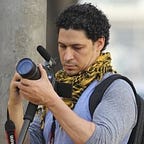Five things you need to consider before buying a digital SLR camera
“The best camera ever” doesn’t exist.
I just want you to know up front, before you read this, that the best camera ever doesn’t exist. The best camera is the camera you can afford that does what you need it to do.
You will never get everything in one camera. It is impossible, because every six months or so the camera manufacturers are coming up with new models that improve on the last model they introduced to the market six months before. They are always introducing newer and more cost-effective technology to enhance existing features, make the most money, and to stay competitive with other manufacturers.
The camera manufacturers may have you in mind when they build and introduce these newer, fancier camera models to the market, however they have their profits and their best interests in mind first. So don’t cough up the money for the newest gadgets on the market unless they address a real problem you know you need to solve.
Make no mistake; they can’t put all the coolest and most amazing features in one camera. If they could build the ultimate camera, you would buy it, but then you wouldn’t ever be upgrading, would you?
The truth about most of the cameras on the market right now is that all of them are really amazing. Even the one you have on your phone it is pretty damn good to take a picture with. So stop looking for the best, and ask yourself, “What do I really need, and how much do I have to spend on a camera?”
First thing to know is that all DSLRs are not created equal, and like everything in life; you get what you pay for.
1- Full frame vs. cropped frame?
If you are looking to shoot a lot of night or dark scenes, the full frame is better option. A full-frame camera can make better use of less light without as much noise as a cropped frame. But it is also more expensive.
2- Higher megapixel vs low megapixel?
If you are going to print in a large format, like a single image covering a ten story building, then higher megapixels is for you. Just keep in mind that most DSLRs out there start at 18 megapixels, which is pretty damn good for most practical large print formats.
3- High ISO?
Higher ISO settings will allow you to take photos in low lights situations. But be careful, because a higher ISO will make your photos grainy. ISO can range from 100 all the way to 6400 and higher in some cameras. The lower the number, the more light you need to capture your image. A higher ISO is useful in low light situations.
4- Camera brand?
Many manufacturers are doing great in terms of what they have to offer technology-wise, and they all seem to introduce cameras around the same time with very similar features. It is very hard to say which one you should buy or which one you might like. Just make sure before you buy your camera to go a store to hold these cameras in your own hands, so you can have a good feel for it. Check out the different menus in each one, and see for yourself how easy it feels to change the ISO, F-stop, and shutter speed.
5-Frames per second?
The shooting speed means how many shots you can take one right after the other. Many DSLRs take about three frames per second, but high-end professional cameras may take twelve frames per seconds or more. “What would you need that for?” you’re asking. Well, if you are shooting sports photographs, that function could be very useful to you. Otherwise don’t worry about that feature; three frames per second or less will be fine.
Finally, remember that in order to take a good photo, you don’t need the “best” camera. That doesn’t exist anyway. You need to be a good photographer, so you will know what features are important to you, and what features will just cost more money without being useful. So work on your skills as photographer, and go shoot something.
